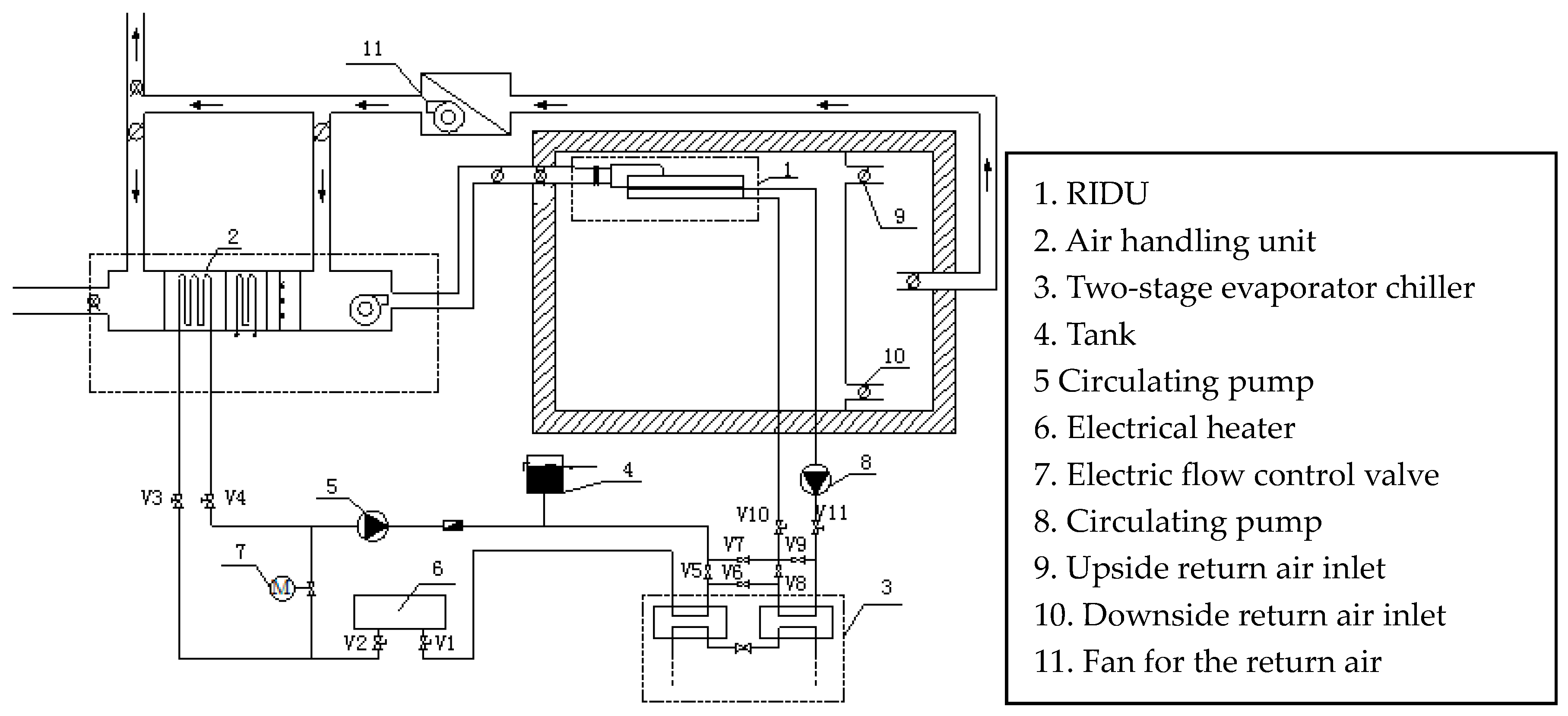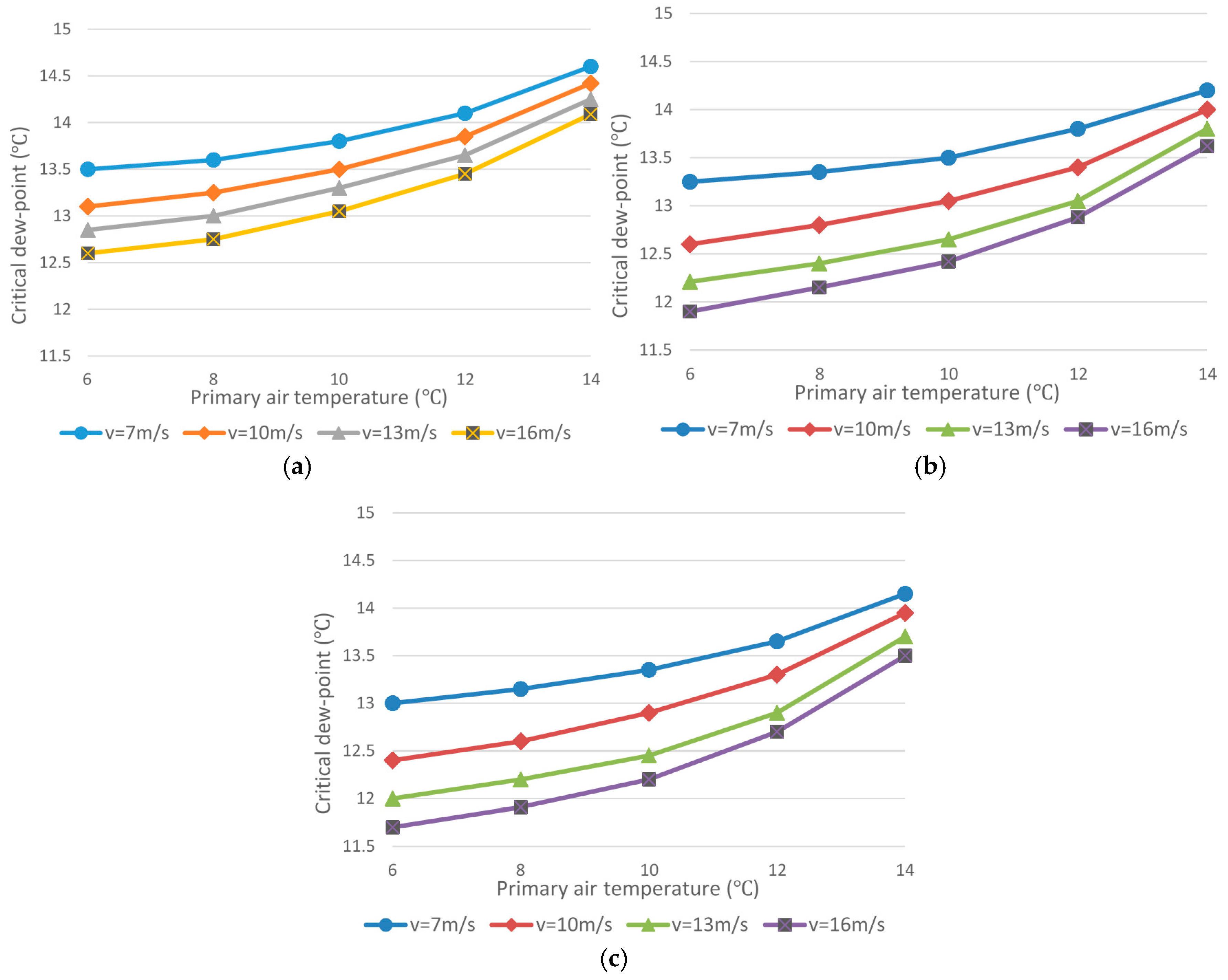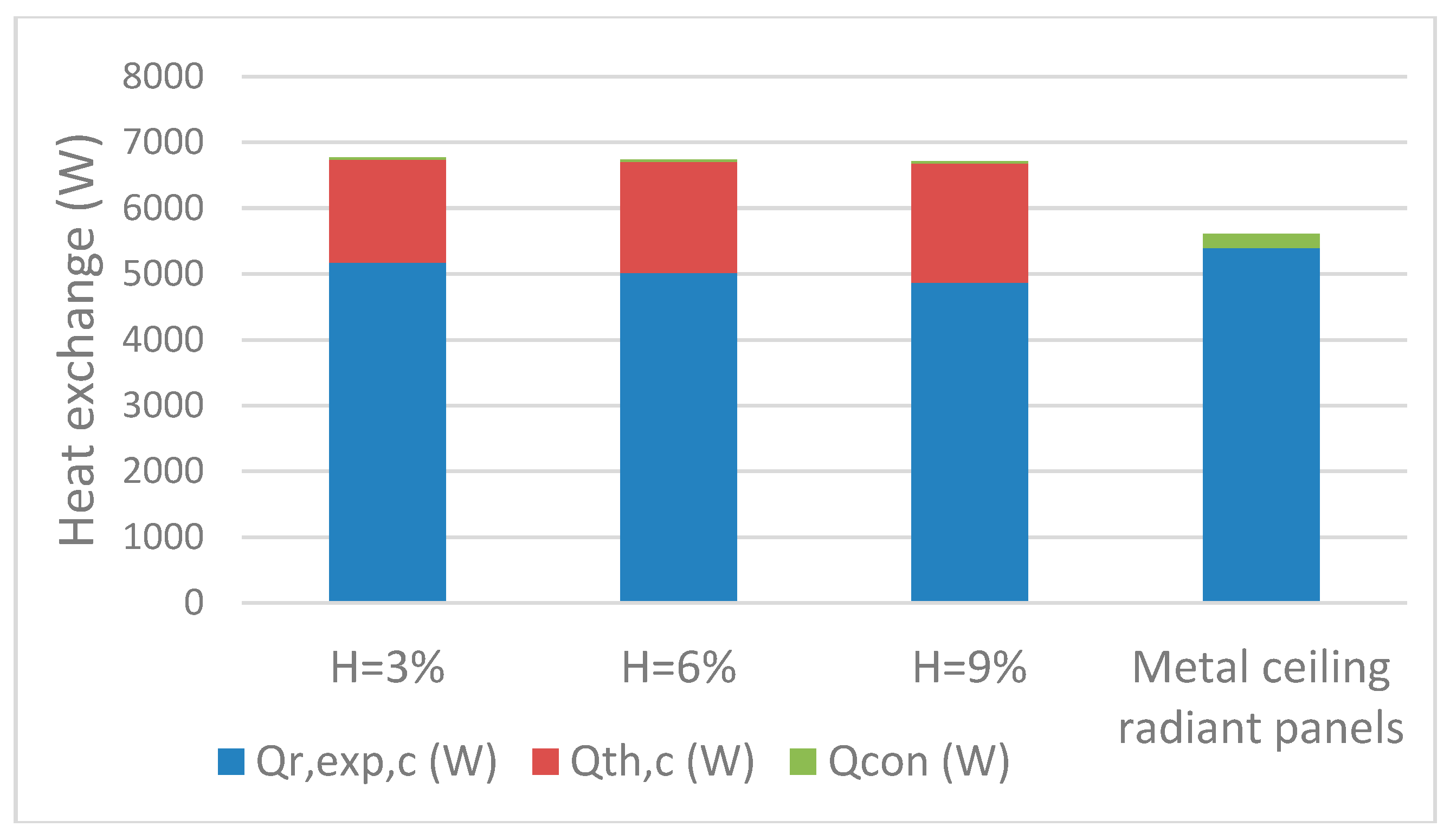Experimental and Numerical Study of the Radiant Induction-Unit and the Induction Radiant Air-Conditioning System
Abstract
:1. Introduction
2. The Experimental System
3. Study of the Induction Characteristics
3.1. Model of the Radiant Induction-Unit
3.2. Mathematical Model
3.3. Results and Discussion
4. Study of the Anti-Condensation Performance of the Radiant Induction-Unit
4.1. The Model of the Pore Radiant Panel
4.2. Mathematical Model
4.3. Results and Discussion
4.3.1. The Primary Air Temperature and the Critical Dew-Point Temperature
4.3.2. The Primary Air Flow Rate and the Critical Dew-Point Temperature
4.3.3. The Opening Ratio and the Critical Dew-Point Temperature
5. Performance Study of the Radiant Induction-Unit
5.1. Mathematical Model
5.2. Experimental Analysis
5.2.1. Validation of the Calculation Method
5.2.2. Calculation of the Convective Heat Exchange
5.2.3. Calculation of the Heat Exchange though the Building Envelopes
5.2.4. Calculation of the Heat Exchange between the Indoor Environment and the Mixed Air
5.3. Results and Discussion
6. Conclusions
- (1)
- The critical dew-point temperature increases as the primary air temperature increases and decreases as the primary air velocity and the opening ratio increases. The opening ratio also influences the variation trend of the critical dew-point temperature. When the opening ratio of the pore radiant panel is 9%, the highest critical dew-point temperature of the RIDU can reach 15.1 °C, which is lower than 20.8 °C of the traditional plate type metal ceiling radiant panel with the same indoor temperature and humidity (28 °C, 65%). Therefore, the induction radiant air-conditioning system has better anti-condensation performance and more extensive applicability. The temperature of the primary air and the chilled water can be lowered to reduce the energy consumption, cooperating with the two-stage evaporator chiller.
- (2)
- Based on the radiation heat transfer theory, the heat transfer characteristics of the RIDU are studied. The calculation error of the simplified model built for calculating the radiant heat exchange was 3%. As the opening ratio of the pore radiant panel increases, the radiant heat exchange decreases and the air supply heat exchange and its proportion increases. The total heat exchange of the RIDU slightly increases. With the primary air the flow rate and temperature of which are 652.50 m3/h and 13 °C, respectively, in the same condition, and the total heat exchange of the RIDU is 16.5% more than that of the traditional plate-type radiant panel.
Acknowledgments
Author Contributions
Conflicts of Interest
Nomenclature
| buoyancy, N | |
| turbulence energy, W | |
| coefficient of the compressible turbulent flow pulsation to the total dissipation rate | |
| total area of the pore radiant panel, m2 | |
| actual radiation area of the pore radiant panel, m2 | |
| total area of the pores, m2 | |
| opening radio | |
| temperature, °C | |
| air flow rate, m/s | |
| heat exchange, W | |
| angel factor of the No. surface of the pore radiant panel | |
| angel factor of the No. surface of the plate type radiant panel | |
| Prandtl number | |
| mixed air flow rate, m3/s | |
| Greek Letters | |
| dissipation rating | |
| turbulent viscosity, Pa | |
| Boltzmann constant | |
| Subscript | |
| average velocity gradient, s−1 | |
| total | |
| cooling | |
| panel | |
| node | |
| pore | |
| pore panel | |
| convection | |
| thermal | |
| experiment | |
| ambience | |
| envelope | |
| m | mixed air |
References
- Bojić, M.; Cvetković, D.; Skerlić, J.; Nikolić, D.; Boyer, H. Performances of low temperature radiant heating systems. Energy Build. 2013, 61, 233–238. [Google Scholar] [CrossRef]
- Takaho, I.; Hirohumi, H.; Masamichi, E.; Hiroshi, S.; Hiroshi, Y. Experimental Study on Performance Evaluation of the Ceiling Radiant Cooling System: Part 2 Comparison between Ceiling Radiant Cooling System and Convection Cooling System in Physiological and Psychological Reaction at the Time of Awaking. In Summaries of Technical Papers of Annual Meeting Architectural Institute of Japan; Architectural Institute of Japan: Tokyo, Japan, 2006. [Google Scholar]
- Takanori, M.; Gyuyoung, Y.; Hideki, T.; Hiroshi, S. Study on the Air-conditioning System Coupling Convection with Radiation by Using Foraminate Ceiling Panel: Part 1 Verification of System Effectiveness by the Experiments. In Summaries of Technical Papers of Annual Meeting Architectural Institute of Japan; Architectural Institute of Japan: Tokyo, Japan, 2007. [Google Scholar]
- Mumma, S.A. Chilled ceilings in parallel with dedicated outdoor air systems: Addressing the concerns of condensation, capacity, and cost, american society of heating, refrigerating and air-conditioning engineers. ASHRAE Trans. 2002, 108, 220–231. [Google Scholar]
- Oxizidis, S.; Papadopoulos, A.M. Performance of radiant cooling surfaces with respect to energy consumption and thermal comfort. Energy Build. 2013, 57, 199–209. [Google Scholar] [CrossRef]
- Feng, J.; Schiavon, S.; Bauman, F. Cooling load differences between radiant and air systems. Energy Build. 2013, 65, 310–321. [Google Scholar] [CrossRef]
- Cholewa, T.; Rosiński, M.; Spik, Z.; Dudzińska, M.R.; Siuta-Olcha, A. On the heat transfer coefficients between heated/cooled radiant floor and room. Energy Build. 2013, 66, 599–606. [Google Scholar] [CrossRef]
- Yang, C.M.; Chen, C.C.; Chen, S.L. Energy-efficient air conditioning system with combination of radiant cooling and periodic total heat exchanger. Energy 2013, 59, 467–477. [Google Scholar] [CrossRef]
- Gao, Z.H.; Liu, X.H.; Yi, J. Experiment study on cooling capacity of capillary-tube radiation air-conditioner. Acta Energiae Solaris Sin. 2011, 32, 101–106. [Google Scholar]
- Dai, Y.; Wang, R. New Development and Perspective of Solar Air Conditioning and Cooling Technology. J. Chem. Ind. Eng. 2008, 59, 1–8. [Google Scholar]
- Khan, Y.; Khare, V.R.; Mathur, J.; Performance, M.B. Evaluation of radiant cooling system integrated with air system under different operational strategies. Energy Build. 2015, 97, 118–128. [Google Scholar] [CrossRef]
- Si, Q.; Zhang, X.S. Performance evaluation and experimental study of the induction radiant air-conditioning system. Procedia Eng. 2015, 121, 1795–1804. [Google Scholar] [CrossRef]
- Liu, J.; Zhang, X.S. Performance analysis of a novel double-temperature chilling water unit using large temperature glide zeotropic mixture. Procedia Eng. 2015, 121, 1222–1229. [Google Scholar] [CrossRef]
- Liu, J.; She, X.H.; Zhang, X.S.; Man, L.; Zhou, W. Experimental study of a novel double temperature chiller based on R32/R236fa. Energy Convers. Manag. 2016, 124, 618–626. [Google Scholar] [CrossRef]
- Liu, J.; She, X.H.; Zhang, X.S.; Cong, L.; Man, L.; Lindeman, B.; Lin, T. Experimental and theoretical study on a novel double evaporating temperature chiller applied in THICS using R32/R236fa. Int. J. Refrig. 2016, in press. [Google Scholar] [CrossRef]
- Xu, X.; Zhang, X. Numerical simulation of air quantity and pressure drop performance of perforated supply air terminals. Refrig. Technol. 2009, 2, 34–37. [Google Scholar]
- Wang, H.; Davidson, M. Jet interaction in a still ambient fluid. J. Hydraul. Eng. 2003, 129, 349–357. [Google Scholar] [CrossRef]
- Morton, B.R.; Taylor, G.; Turner, J.S. Turbulent gravitational convection from maintained and instantaneous sources. Proc. R. Soc. Lond. A 1956, 234, 1–23. [Google Scholar] [CrossRef]
- Enjalbert, N.; Galley, D.; Pierrot, L. An entrainment model for the turbulent jet in a coflow. Comptes Rendus Mec. 2009, 337, 639–644. [Google Scholar] [CrossRef]
- Wang, H.J. Jet Interaction in a Still or Co-Flowing Environment. Ph.D. Thesis, Hong Kong University of Science and Technology, Hong Kong, China, 2000. [Google Scholar]
- Hodgson, J.E.; Moawad, A.K.; Rajaratnam, N. Concentration field of multiple circular turbulent jets. J. Hydraul. Res. 1999, 37, 249–256. [Google Scholar] [CrossRef]
- Zhang, Z.L.; Zhang, X.; Zhang, E.Z. Experiment of induction ratio of the diffuser with nozzles. Heat. Vent. Air Cond. 2008, 38, 62–64. [Google Scholar]
- Chen, C.; Cai, W.J.; Giridharan, K.; Wang, Y.Y. A hybrid dynamic modeling of active chilled beam terminal unit. Appl. Energy 2014, 128, 133–143. [Google Scholar] [CrossRef]
- Koskela, H.; Häggblom, H.; Kosonen, R.; Ruponen, M. Air distribution in office environment with asymmetric workstation layout using chilled beams. Build. Environ. 2010, 45, 1923–1931. [Google Scholar] [CrossRef]
- Ahmed, K.; Kurnitski, J.; Sormunen, P. Demand controlled ventilation indoor climate and energy performance in a high performance building with air flow rate controlled chilled beams. Energy Build. 2015, 109, 115–126. [Google Scholar] [CrossRef]
- Chen, C.; Cai, W.J.; Wang, Y.Y.; Lin, C. Further study on the heat exchanger circuitry arrangement for an active chilled beam terminal unit. Energy Build. 2015, 103, 352–364. [Google Scholar] [CrossRef]
- Guan, Z.M.; Wen, C.Y. Geometric optimization on active chilled beam terminal unit to achieve high entrainment efficiency. Appl. Therm. Eng. 2016, 98, 816–826. [Google Scholar] [CrossRef]
- Nelson, I.C.; Culp, C.H.; Rimmer, J.; Tully, B. The effect of thermal load configuration on the performance of passive chilled beams. Build. Environ. 2016, 96, 188–197. [Google Scholar] [CrossRef]
- Fluent, Inc. Gambit User’s Guide 2007; ANSYS, Inc.: Pittsburgh, PA, USA, 2007. [Google Scholar]
- Chludzinska, M.; Mizielinski, B.; Bogdan, A. Application of the thermal manikin for ventilation and air-conditioning system assessment. Environ. Eng. 2010, 3, 121–126. [Google Scholar]
- Wu, W.Q.; Lin, Z. Experimental study of the influence of a moving manikin on temperature profile and carbon dioxide distribution under three air distribution methods. Build. Environ. 2015, 87, 142–153. [Google Scholar] [CrossRef]
- Kilkis, L.B.; Sager, S.S.; Uludag, M. A simplified model for radiant heating and cooling panels. Simul. Pract. Theory 1994, 2, 61–76. [Google Scholar] [CrossRef]
- Min, T.C.; Schutrum, L.F.; Parmelee, G.V. Natural convection and radiation in a panel heated room. ASHRAE Trans. 1956, 62, 337–358. [Google Scholar]
- Lu, Y.Q. Practical HVAC Design Manual; China Architecture & Building Press: Beijing, China, 2008. [Google Scholar]
- TROX Ltd. TROX TVR-Easy User’s Guide 2016; TROX GmbH: Neukirchen-Vluyn, Germany, 2016. [Google Scholar]





| Case | Model Number | Size of the Induction Return Air Inlet | Size of the Pore | Primary Supply Air Flow Rate (m3/h) | ||
|---|---|---|---|---|---|---|
| Length (mm) | Width (mm) | Length (mm) | Width (mm) | |||
| 1 | A | 1200 | 90 | 150 | 30 | 652.5 |
| 2 | B | 1600 | 150 | 120 | 30 | 652.5 |
| 3 | C | 1200 | 90 | 120 | 30 | 652.5 |
| 4 | C | 1200 | 90 | 120 | 30 | 471.2 |
| 5 | C | 1200 | 90 | 120 | 30 | 321.9 |
| Case | 1 | 2 | 3 | 4 | 5 |
|---|---|---|---|---|---|
| The volume flow rate of the primary air (m3/h) | 652.50 | 652.50 | 652.50 | 471.20 | 321.87 |
| The volume flow rate of the inducted return air (m3/h) | 421.32 | 342.51 | 341.78 | 230.15 | 133.21 |
| The volume flow rate of the mixed air (m3/h) | 1073.82 | 995.01 | 994.28 | 701.35 | 455.08 |
| The induction ratio | 0.64 | 0.52 | 0.51 | 0.48 | 0.41 |
| Supply air temperature of the pore radiant panel (°C) | 18.31 | 15.61 | 15.57 | 14.91 | 13.72 |
| No. | 1 | 2 | 3 |
|---|---|---|---|
| Opening ratio H (%) | 3 | 6 | 9 |
| Pore size (mm) | 40 × 10 | 80 × 10 | 120 × 10 |
| Opening Ratio | Critical Dew-Point Temperature | |
|---|---|---|
| % | Highest (°C) | Lowest (°C) |
| 3 | 15.1 | 12.5 |
| 6 | 13.9 | 11.8 |
| 9 | 13.2 | 11.3 |
| Envelope | Heat Transfer Surface Area (m2) | Thermal transmittance (W/m2K) |
|---|---|---|
| Southern exterior wall | 8.8 | 2.92 |
| Southern exterior window | 3.2 | 2.5 |
| Southern exterior door | 3.6 | 2.5 |
| Northern interior wall | 14 | 3.92 |
| Northern interior door | 2.9 | 3.5 |
| Eastern interior wall | 21 | 3.92 |
| Western interior wall | 21 | 2.76 |
| Floor | 66 | 3.3 |
| Ceiling | 58 | 3.3 |
| (%) | (W) | (W) | (W) | (W) |
|---|---|---|---|---|
| 3 | 6635 | 1557 | 5078 | 5202 |
| 6 | 6703 | 1687 | 5016 | 5094 |
| 9 | 6791 | 1849 | 4942 | 4979 |
© 2016 by the authors; licensee MDPI, Basel, Switzerland. This article is an open access article distributed under the terms and conditions of the Creative Commons Attribution (CC-BY) license (http://creativecommons.org/licenses/by/4.0/).
Share and Cite
Si, Q.; Zhang, X. Experimental and Numerical Study of the Radiant Induction-Unit and the Induction Radiant Air-Conditioning System. Energies 2017, 10, 26. https://doi.org/10.3390/en10010026
Si Q, Zhang X. Experimental and Numerical Study of the Radiant Induction-Unit and the Induction Radiant Air-Conditioning System. Energies. 2017; 10(1):26. https://doi.org/10.3390/en10010026
Chicago/Turabian StyleSi, Qiang, and Xiaosong Zhang. 2017. "Experimental and Numerical Study of the Radiant Induction-Unit and the Induction Radiant Air-Conditioning System" Energies 10, no. 1: 26. https://doi.org/10.3390/en10010026





